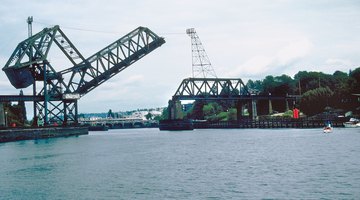Types of Drawbridges
A drawbridge is a form of bridge that can be moved, lifted or otherwise taken out of the way so no one can cross the bridge. These bridges were used in ancient fortifications that stood behind a large hole, moat or crevasse. Modern drawbridges usually serve two functions.

When spanning rivers, drawbridges cross the gap to let traffic such as trains and other vehicles across. Then part of the bridge lifts, slides or turn to allow river traffic through. There are three types of early drawbridges: sliding, lift and bascule. Modern technology has added the turning drawbridge.
Sliding Drawbridge
The sliding platform is a simple plank or set of planks lashed together that slide over the water source or hole and is pulled or drawn back in by ropes. This is the easiest to use by hand but it has been updated for modern use and renamed the retractable bridge. Using engines, part of the bridge is pulled back under the remaining part of the bridge to allow larger ships through.
Lift Drawbridge
The second type, the lift drawbridge, is the one that captures the imagination. Also called a vertical lift drawbridge, a set of lashed planks of wood is lowered over the water source with rope or chains attached to either side of the far end. The rope (or chains) would be attached to the top of a structure on the other side of the water source. The bridge is then lifted from the structure and pulled flush to the structure. This design is still used in modern drawbridges. It is limited by the height of the structure and the larger the bridge the harder it is to lift the bridge high requiring height limits for ships passing though. Modern versions use electric and oil engines to pull up the bridge.
Swing Drawbridge
A swing or turning drawbridge lifts and rotates the middle of the bridge above the remainder of the bridge. The turnable pier must be large and able to lift heavy loads. Hydraulics are used to lift the bridge out of the channel it spans.
Bascule Drawbridge
The bascule drawbridge uses a a counterweight to lift the bridge. Some bascule drawbridges used the weight of the castle gate or portcullis to lift the bridge. The modern version of the bridge rotates vertically to allow ships to pass through. There are no height restrictions with this type of bridge. Because of how the movable parts rotate, the bridge usually has heavy weight restrictions to keep the bridge aligned. Heavy loads could drop the bridge unexpectedly.
References
Writer Bio
Native of Colorado and single mom, I’ve been designing websites for over 16 years. I am fluent in HTML, CSS and web standards. I work with Wordpress, Drupal, and other content management systems. I have extensive social media experience and have been integrating analytics, web sites and social media for years. I have designed for non-profits, corporations and artists. Give me a text editor and code to write and I’m content.
Photo Credits
- Jupiterimages/Photos.com/Getty Images
- Jupiterimages/Photos.com/Getty Images
More Articles



